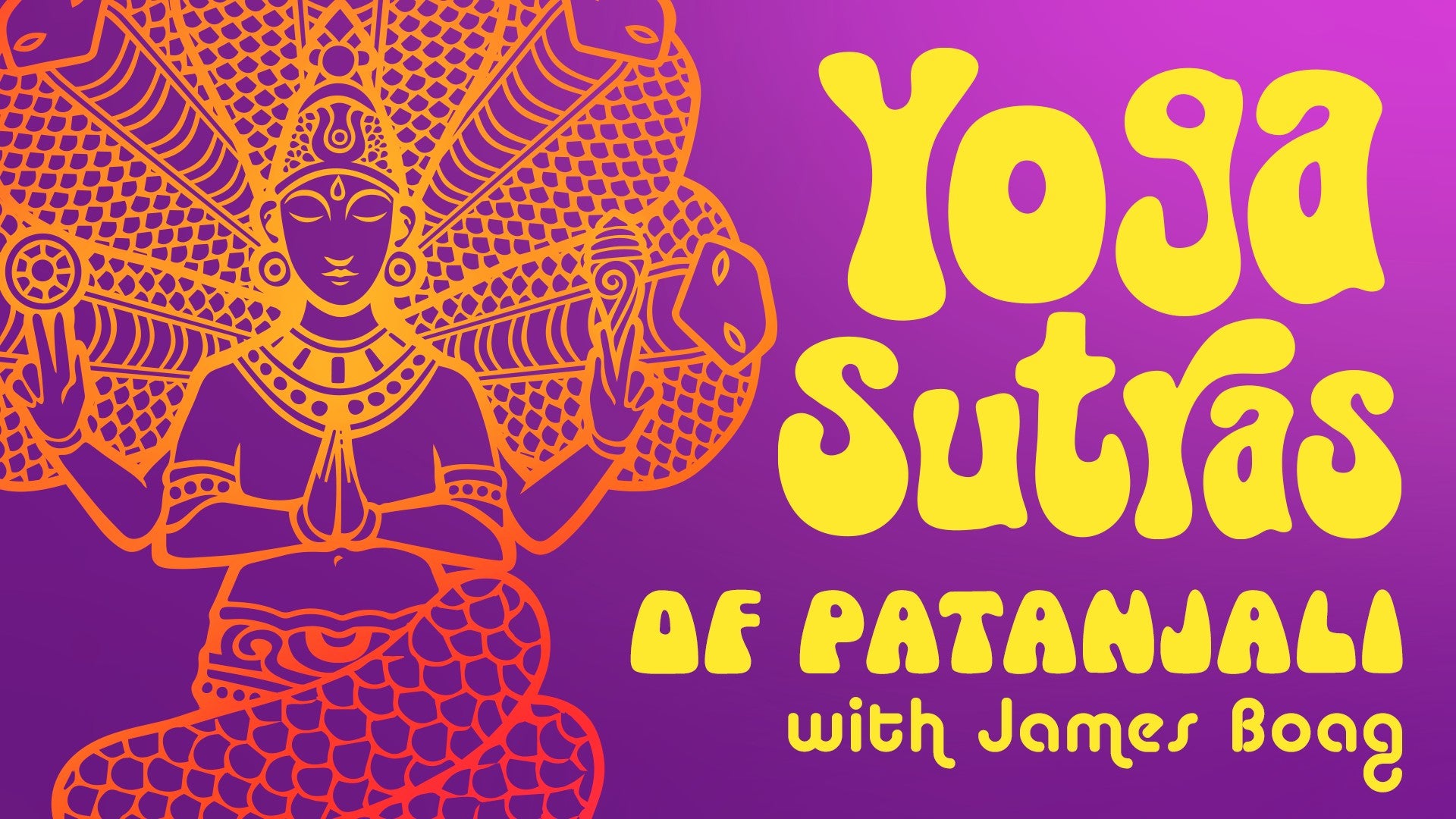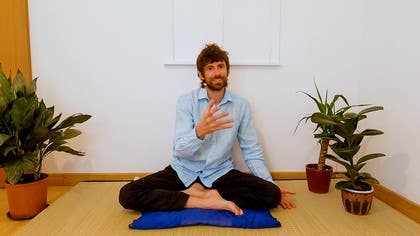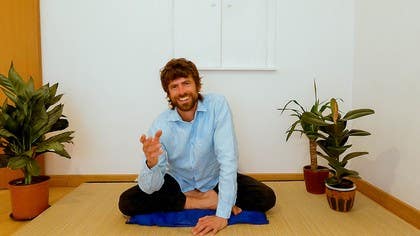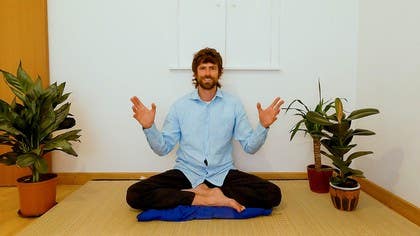Description
About This Video
Transcript
Read Full Transcript
So, Patanjali has taught us about the drishya, the scene, the manifest world of nature. Now he's going to talk about the drashta or the drashtra, the seer. So he mentioned earlier it's the sanyoga, this very strong association of these two, of the seer and the scene, that is the cause of us not being able to actually recognise who we really are. And this is the cause of the pain that is to be removed, the suffering that is to be avoided. He's described in these amazing sutras that distill so much into so little, especially sutra 18, the nature of manifest existence. And now he turns to the underlying pure consciousness. So sutra 20, drashta drishimatra shuddho pey pratyayana pasha. So, drashta, the seer. Drishimatra is only seeing, is only pure consciousness. However, how does it see? Anupasha, pasha means seeing, anu, following, pratya, following that which is basically presented to it. So even though the seer is only pure consciousness, it sees and experiences following the idea or images or notions that are displayed or presented to it with the lenses of our awareness. So it's the idea that whatever is placed on the lens of our awareness is what the underlying seer will experience. And that experience also begins to colour and influence our understanding of who we are. But this lens, what we know about the lens, the lens can get tinted or clouded or shrouded or veiled or covered in layers of dust as we move through the world. So the seer is pure consciousness. That's one of the key ideas in this sutra and the yogic understanding of our essence. Krishna in the Bhagavad Gita, for example, talks about the soul or the essence or the underlying seer, the underlying consciousness as basically inviolable, untouchable, unwettable, undriable, uncleavable. There is a part of ourselves that never dies that no one can touch. Now, interesting, I think it was in some of the Kannanda's writings, he said about the soul, it's not the soul loves, the soul is of the essence of love. It's not that the soul knows, the soul is the essence of knowing. It's a little bit abstract, but there's that idea that the actual soul is pure consciousness. It's that which enables the experience and we experience through these lenses of our instrumental powers of awareness. So the idea in yoga is, can I bring the instrumental powers of my awareness as far as possible into an equi-state, a state of equilibrium, equipoise clarity so they can actually allow me to experience the underlying conscious essence more accurately, more as it really is, with less distortion, with less veil, with less dust. So when we look at this sutra, different commentators or people who look from different perspectives, they might read it slightly differently. So some people consider that Purusha and Prakriti, like in the Sankhi model, are separate. In some schools of yoga and in Tantric schools of yoga, the seer and the seen sometimes are referred to, for example, as Shiva and Shakti. And the eyes that Shiva and Shakti are never really separate. They are two aspects of the same underlying oneness. Now, in this sutra, potentially is telling us the seer is pure consciousness only, but it sees following that which is displayed to it on the lens of our awareness. So from the small, let's say, Sankhi point of view, there is the Purusha and it's like it's separate from us, but we are very closely connected to it. We're related to it. The Tantric perspective is more our underlying essence is that consciousness, but we just can't quite recognise it yet. Now, from my perspective, whether we consider it's this moduleistic reading or this more underlying oneness reading, practically speaking, we can still work with the instruction or direction or guidance of the sutra in a very similar way. The key idea here is that our conscious essence is pure consciousness. And we would like to recognise that we would like to attune more to that, whether we have the idea that that pure consciousness is separate from the instrumental powers, though very closely related to them, or is actually the very source and fabric and underlying substrate of the instrumental powers. Practically speaking, it doesn't really change much for me as a practitioner where I'm practising anyway. Now, to illustrate a little bit more this idea of how the seer is pure consciousness, but it sees depending on what is placed or displayed to it on the lens of awareness, there are two traditional images or illustrations I would like to refer to. And one of them comes from Vedanta. And Vedanta is another school of classical Indian philosophy that is closely related to Sankhya and yoga, but there is also distinct from them in some ways. But in Vedanta there is this very helpful image that describes the underlying consciousness and the means of seeing as the moon and a lake. So imagine the full moon and it is shining its light down on a lake. But on the surface of the lake the wind is playing a little bit. And so the ripples on the surface of the lake, what do they do to our perception of the moon? We're seeing a blurry moon. We're seeing it not quite as it is. So this is the idea of how we kind of misunderstand who we really are and what we're really made of. Because the underlying conscious essence that we really are our understanding or apprehension of it gets distorted because of the wind, the ruffles in the surface of our being. And I'm going to mix the metaphors here, but really kind of intentionally. So there's the light of the moon and the surface of the lake of our awareness is rippling in that breeze, is perturbed. The surface of the lake of our awareness, which is actually the field of our psyche. So the moon is playing on the superficial, the surface, the superficial level of the lake or field of our psyche. So I intentionally mix the idea of the lake and the field to drive home hopefully a point here that if we try to describe the ultimate source consciousness in very literal language, we're basically going to chase ourselves down a blind alley, a cul-de-sac, a place from which there is no way out. Because if we try to use those very literal terms, what will happen? The literal language will, by its very nature, confine something which is so vast, something which is vaster than literal language, is capable of rendering wholly accurately. So we have to take recourse to the realm of poetry or the realm of metaphor and the realm of image and symbol. Now, I really love poetry, so I don't mind that. But nonetheless, even if a person isn't particularly of that mindset, how useful is this image? Imagine the lake.
You go to the lake. The moon is up there in the sky. And when you look up in the sky, the moon is unmoving. It's a clear orb. And perhaps it's got that, I've forgotten the proper name, the aura of the moon. What's it called? Maybe it'll come to me later, but there's that kind of lovely glow around the moon. And then I look at the lake and what do I see? I see this shaking, constantly morphing thing and that lovely aura is not really reflected in a way that is so representative of what I would see if I looked up. So the lake is rippling and how much ripple is playing in the field of our psyche, in the field of our awareness. How much movement and perturbation because of the influence of the Gunas and the influence of my ideas and my attachments. So what often happens is when I start, for example, to cultivate meditation, when I start meditation practice, one of the things that often practitioners recognize is like, wow, my mind is sometimes so noisy, so chattery, so reactive. And those reactions are often based on habits and sometimes on woundings. And sometimes I'm trying to compensate for lacks that I have allowed to emerge because of my own complacency or lack of awareness. And I realize, oh yes, there's relatively speaking, there is a significant amount of perturbation in the field of my awareness. And so the surface of the lake does get disturbed. But if the ripples stop, then the lens of my awareness can then reflect more accurately the light of the moon. If I can bring that stillness into the field of my awareness, then I can grant myself access to a clearer savoring, relishing, sensing, appreciation, grasping, experiencing of the underlying conscious essence. So that's the image from the Ananta of the moon on the lake. There is another image which comes from Sankhya. And this image, it says that the purusha, the seer, the drastre is like a mirror that is needed to see a hidden place, but which is not altered by the image it shows. So in other words, I'll just, I'll restate that. So the drastre, the purusha is like a mirror and that mirror is needed to see a hidden place, but the mirror itself is not altered by what it's, by the image it shows or displays. However, the mirror that we, allows us to see these things that previously were hidden, the mirror is underneath a lens, the lens of the instruments of our awareness. So as we go through life, this mirror allows us to have experiences, but we see the mirror, the reflective surface is underneath a lens. Now what happens as I walk along the highways and byways and muddy bridleways of life, the lens gets dirty. For example, in my own life, it has been, I've been quite nomadic. I've been used to traveling a lot and I'm filming today in 2021. And for the last year, I've been more or less in one place, which has been very, totally extraordinary. It's the first time it's happened this century. And as my normal modes of travel and movement were not possible, I thought, hmm, let me invest in a new bicycle. I had an old bicycle and it has done stalwart service for decades, but I took it out on a rather long ride, actually probably just a little bit more than a year ago. And I realized, hmm, it's not quite so well adapted for longer journeys. And if I'm not able to travel by the means that I am used to traveling, a more comfortable bicycle might be a very sound investment. And so I invested in a solid touring bike, nothing fancy, just a bike that's designed for comfort for long journeys. And I bought this new bicycle, but not that long after I bought it, I made an additional investment. And the additional investment was I bought mud guards, also known as fenders, because what happens when you go out riding, when you go along the highways and byways of life and the trails, what happens? The vehicle accumulates dirt. This is inevitable. The vehicle, as we go through life, it accumulates dust. So in other words, while the mirror itself is not altered by what is displayed on its surface, what it helps us experience, the lens can get covered in all sorts of a veiling dust as we proceed through life. Now, we all live in some type of dwelling space. When one lives in a house, it doesn't take very long to realize that housework is never done. Even if I make a very thorough effort to clean the house, in the very act of putting away the cleaning instrument, some fresh dirt will be displaced. It's a never-ending task. The vehicle, as it's going along the highways and byways, it's going to accrue dust. So on my bicycle, I can take a damp cloth and I can scrub some of that dust off, for example. I can get my oily rag and I can clean the chain, for example. What about cleansing the lenses of the instrumental powers of my awareness?
A yogic recipe. Can I invite them to bathe in the serene, calm waters of Samadhi? Can I, as it were, flood the system with the serenity and clarity of Samadhi to gradually efface all those layers of accrued veilings? Now, I mentioned housework. What happens when I do this at the yogic level? I start to invite greater balance, greater clarity. When I start cleaning the house, spring cleaning, what do I realise? Oh, wow. I start cleaning and I uncover more dirt, deeper down layers. Dirt I hadn't even realised was there. Same with yoga. I invite clarity, equipoise balance into the field of my awareness. I bring the lake, as it were, into greater serenity. As I still the surface of my mind, of my awareness, as the surface of the lake becomes calm, it's no longer rippling. It can reflect the moon accurately, but let's say now it's daytime. If the water is all a ripple, I can't see very deep, but when the water becomes still and now I look into the lake, how deep can I see now? A lot more deep, but maybe I won't see all the way to the bottom. Even if I do get the odd glimpse all the way to the bottom, what else do I see? Oh, wow. There's a whole lot of trash down there in the lake or field of my psyche. There's a big underground underwater cave, sub-aqua cave network, and in those caves, oh, oh, there's some fearsome dragons hoarding all sorts of treasure. If I'm going to reclaim that treasure and bring myself into integration, then the housework is going to have to be seen to with persistence and tenacity and regularity and constancy. So basically, same idea that we've encountered previously. Practice is a long-term, unbroken, constant, steady effort. As long as we're in the realm of the Gunas, perturbation in the mind that stirs up dust and brings covering and veiling and dirt to the lens of our awareness that obscures our recognizing who we really are, this is an ongoing feature of the game. So if we're going to play this game, we have to be steady. We have to be patient. And as best as we can, we have to keep tuning in to our conscious essence by harmonizing, bringing into greater serenity all the different powers through which and with which we see, and which, when they come into that state of calm, can help us recognize the underlying animating conscious essence.
Yoga Sutras of Patanjali: Life is the Guru
Comments

You need to be a subscriber to post a comment.
Please Log In or Create an Account to start your free trial.








